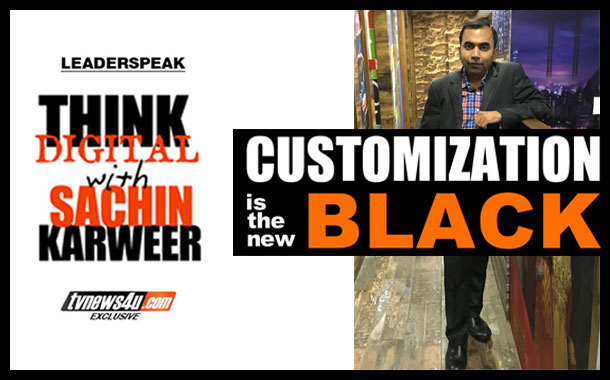
(Tvnews4u.com continues its exclusive knowledge series on Digital Marketing, Think Digital With Sachin Karweer, Business Head – Hinduja Global Solutions Interactive, who writes about the Digital Marketing space, from the knowledge, skills, experience and effectiveness perspectives. This column will offer insights into trends and specific developments, and their impact on the industry and the business of marketing a company or its offerings to the millions of people who are so active on digital, online and social media today. Whether you are into traditional or digital marketing, we welcome you to ride the digital wave and Think Digital With Sachin Karweer. Every week. Your inhouse Digital Marketing program. For understanding, perspective, practice – Editor)
In today’s digital arena, what businesses need is a digital marketing solution that not only looks good but is also customised.n the past, marketing plans involved aimlessly posting signs, blindly handing out flyers and buying limited advertising space in the newspapers, hoping to better target the intended audience. Back then, traditional businesses communicated through their sales-people who connected and aimed at building a real-life conversation with customers in order to understand what the customer wanted. Presently, we are in an age where consumers are tech-savvy and constantly connected to social networks, making digital marketing the best thing to happen to the advertising sector.
‘Customisation’ is currently a hot buzzword on the digital landscape. Philip Kotler has rightly said that customisation, along with quality, is king. This weapon has come into play for businesses and extends to much more than just welcoming back a returning customer or showing recommendations based on their earlier purchases. It is all about using deep data to encourage customers to take action and come back again.
I think it’s crucial that brands deliver customisation with memorable touch points throughout the journey to their consumers. They need to find ways to identify their likeliest prospects and tailor their marketing message to the needs and interests of those prospects. It is all about putting the philosophy into action to generate higher conversions, improve the brand’s relevance and to gain loyalty.

Marketing customisation is a broad strategy that can involve as many channels and clever tools as possible — from customised direct mail and triggered email to specialised web content and ad retargeting. The choice of tactics for customisation depends on the budget, business models and the profitable use of resources. I always recommend that brands stand out from the pack by moving away from mass-blasts and towards more personalized communication. In a survey conducted by Chief Marketer, 81% — that’s more than four people out of every 5 — said they now customise their marketing to some extent, against 16% who don’t. This speaks volumes about the power of customised digital marketing.
Now that we’ve touched upon the basics, let’s move to the customisation possibilities step by step:
Customisation starts with a comprehensive database
The deep data revolution has witnessed several businesses embrace their customer data and improve their analytics implementations to truly understand their consumers. Tech-savvy digital marketers can now effectively measure how audiences they target behave online and understand their unique behaviours and traits using robust optimisation roadmaps and high-calibre testing plans and processes.
Equipped with this intelligence, marketers can identify unique conversion paths, understand the role played by their websites and apps, and identify the factors that can transform their audience into a customer. At the end of the day, it is all about optimizing their customer journey by using this data and creating a frictionless, seamless experience for them.
The power of the World Wide Web as a precision marketing tool
The concept of customisation for customers, though not new, is certainly an art to be mastered by all businesses. The World Wide Web is the perfect marketing setting for precision marketing because individuals can be uniquely identified, and a message can be tailored specifically for them. However, you must note that full customisation is required in order to ask questions, listen to each individual’s answers, and observe their actions on a website. This requires much more than customisation technology.
Let me explain.
For the consumer to experience the unexpected, there needs to be a team of content creators ‘behind the scenes’ who are constantly working on the development of the material so that the customisation engine can actually customise the content based on her or his profile. In a way, it’s almost like a conversation carried out between the content creator and the consumer through the website and other online platforms.

Several companies implement some level of personalisation into their marketing campaigns, with web-based companies leading the way. There are also several companies leading the way offline in terms of product customisation. This brings to mind the example of Dell Computers, who, since a long time, have welcomed customers to “build” their computers online by choosing and picking the different hardware configurations for their machine themselves. At the heart of Dell’s customised computer sales is essentially an assembly process that swiftly delivers exactly what the customers ask for.
Here’s another great example of a customised digital marketing strategy well done: Burberry launched digital ads that responded to consumer interaction in an effort to endorse its latest online and in-store tailor-made scarf service. The Burberry Scarf Bar enabled customers to select from a range of more than 30 scarf colours and shades of thread to customise the product with monogrammed initials for the very first time. Burberry promoted this service with a short film across all digital platforms celebrating its scarf-making legacy with personalised digital ads which replied to consumers who came in contact with them.
This campaign provided their consumers an effective platform for regular one-to-one personalised communication, with influencers and ‘top consumers’ getting exclusive invites to events, thus giving them a platform to voice their suggestions regarding the product.
These digital and technological solutions have been successful in aligning with a marketing strategy aimed at superior customer expectations management.
The benefits of a customised marketing campaign.
Customisation has an impact across a range of other marketing campaigns. Businesses need to realise that consumers expect to be treated as individuals and that one size does not fit all. Every consumer is unique with their set of demands or needs. Consumers expect the brand to pay attention to their specific needs. Establishing a social media presence across a variety of social media channels like Twitter, Facebook, Tumblr and various apps is an effective way to reach them.
However, it is all about going beyond replying to tweets or ‘liking’ a Facebook comment. Brands need to go that extra mile and win them over through loyalty programs, recognition events and give them special access to sales and other promotional events based on their preferences. Brands have to create an impression that each and every consumer is special and unique.
Let’s look at Dr. Pepper, who in June this year launched its Pick Your Pepper campaign, distributing several new, limited-edition custom-printed 20-ounce bottles. What it aimed to achieve was creating nostalgia in the minds of the consumers and tapping into their passion for self-expression. The campaign emphasised on individuality, urging consumers to pick a label that spoke uniquely to them. This encouraged 4,000 GIF combinations, inspired by gaming, fashion, cat lovers, 90’s retro lovers and vinyl collectors. Keep your eyes peeled as these bottles will soon be in the market.
Other successful customer-specific personalisation campaigns worth a mention are Starbucks Name My Cup campaign and Coca Cola’s personalised can and bottle campaigns.
Wow your customers with an individually-oriented Digital Marketing Strategy.
While designing a digital marketing strategy, most businesses know that they need to keep in mind their target consumers, the product, the competition and location, but it is crucial to pay very close attention to detail. It is all about focussing on articulated needs as expressed by the consumers, or the perception of the business regarding the consumers’ articulated needs.
There is a sea change in the way customers interact with brands these days. They are beginning to take an active role in the product development, purchase and consumption process in the digital landscape, which is an emerging paradigm known as ‘customerisation’.

Marketing strategies can no longer stick to being buyer-oriented; it has to be individual-oriented. There are many businesses that have been inept at figuring out what consumers have on their mind and what they really want.
For instance, Clothier Primark caters to its customers through its website ‘Primania’, where they can upload pictures of themselves wearing Primark clothing. Primania strikes a chord with consumers by appealing to their self-love and cashing in on the “selfie” culture. Other shoppers can rate the uploaded “looks” and the website also welcomes users to sign up for prizes and talk about fashion and the latest trends.
There are also several businesses which design their products after the consumers tell them about what they want to buy. Let’s take the example of Nike here, who launched a digital marketing strategy backed by a microsite that enabled customers to customise their trainers using their Instagram picture. Once the Instagram image had been selected, Nike created a colour scheme for the trainers that matched the colours in the picture. Once customised, the shoe design could be shared on Instagram, Facebook, Twitter, Pinterest, Tumblr and Google+. Customers could easily buy their new personalised trainers from the Nike’s mobile store with just a few clicks. 100,000 shoes were created in the first week itself!
How does a brand achieve this level of engagement? The secret behind it is deep data, and there are several methods to acquiring this data, either through specialised teams following, monitoring and analysing conversations on command centres, online forums, keyword analyses, questionnaires, data-mining, surveys, feedback on social media and other platforms. To be able to hear what your consumer needs, it’s important to be listening in on them.
Involve the consumer directly in the process of customisation.
This concept kills two birds with one stone, by engaging with existing customers and, simultaneously, drawing in new customers to their website. Let me share the example of Longchamp, who runs a Facebook application that enables customers to turn into designers and share their handbag creations online. There are also companies that give customers a chance to create a virtual catalogue showcasing all their designs.
What companies can do is acknowledge and rank the most creative customers, making them design leaders. An example of this is The North Face, who launched a design gallery for its Denali jackets created by customers themselves. Jeld-Wen has enabled customers to co-create and share door designs in real-time, serving as an inspiration. Now you can see how engaging customers through customisation raises the stakes and boosts customer experience.
Another interesting example worth mentioning is the customisation approach employed by online grocer, Peapod. The website is designed in a way that it gets to know the customers so well that it can do a personal chore, like food shopping, for them too! The website’s system learns the items on the personal shopping list, finds the prices of groceries from real grocery stores, picking products that meet the needs and delivering them to the consumer’s doorstep. In addition to that, the website allows them to collect information on the products purchased often and on special occasions, enables the website to identify and deliver the produce. It doesn’t end here, it also offers specialized features like electronic coupons and sales advertisements.
Using this service, customers greatly reduce their shopping time, eliminate product categories of no interest to them, and keep running totals of purchases so that they can spend well within their budget. Peapod customises and enhances the shopping experience, aiding customers and listing items available on hand, and then suggesting recipes where these items can be used. What more could anyone want?
The need for capabilities that can sustain a one-to-one personalised relationship.
The personalisation process creates higher expectations on the part of customers as they expect the products or service they receive to match their needs and wants perfectly. So, if the process fails to meet the expectations, the loss is far greater than while buying a standardised product or service. Companies need to have effective marketing and manufacturing capabilities to sustain a one-to-one relationship and to deliver what the customer wants efficiently.
A company may use traditional advertising to woo potential customers to visit an informational website. At this website, customers can fill out a questionnaire and then receive a printed or electronic newsletter targeted to their particular concerns. The newsletter can offer customised messages and products customers need.
This customisation strategy can be supplemented with a process, wherein the customer can customise the information and the products and services they would like to receive as well. It is crucial that businesses combine data-mining techniques along with existing databases backed by customisation strategies once the business knows about a customer, or what the customer does while at its website.
Be aware of the shortcomings of offering too much personalisation.
Not a lot of people like to talk about this, but it is important to note that there is a risk to customisation as well, if not executed well. Too many options can leave the consumer confused. That’s the reason why most companies limit the number of features that can be tailored. There are several products where some customer segments have needs that are best satisfied by product customization but huge costs are involved in satisfying those needs. In such a scenario, both customers and businesses face a trade-off situation and customisation has to be evaluated carefully.
In the age of Apple’s virtual assistant, Siri, where all your home products can be operated by installing a couple of sensors, it is now possible to know the needs of the customers in real time. Businesses can now get as close to them as possible and offer them what they need the minute they wish for it. It won’t be long when there will be a smart cupboard to tell everyone when it is time to shop and what the best deals at the nearest malls are.
(You can email the author at [email protected])
















